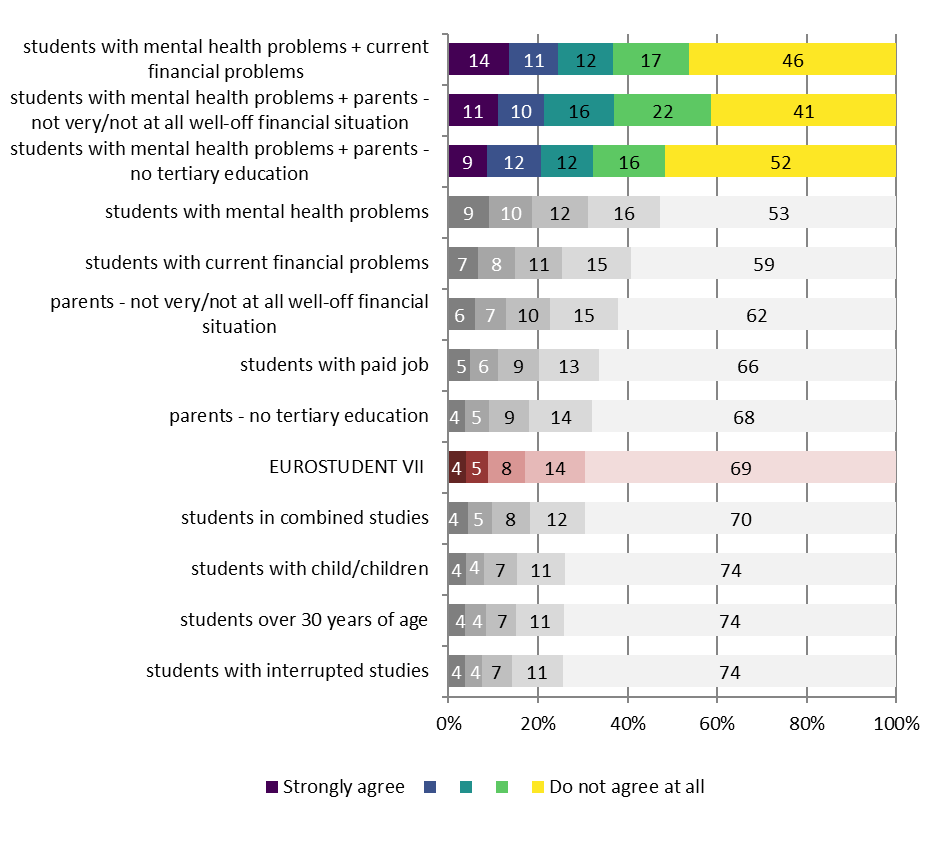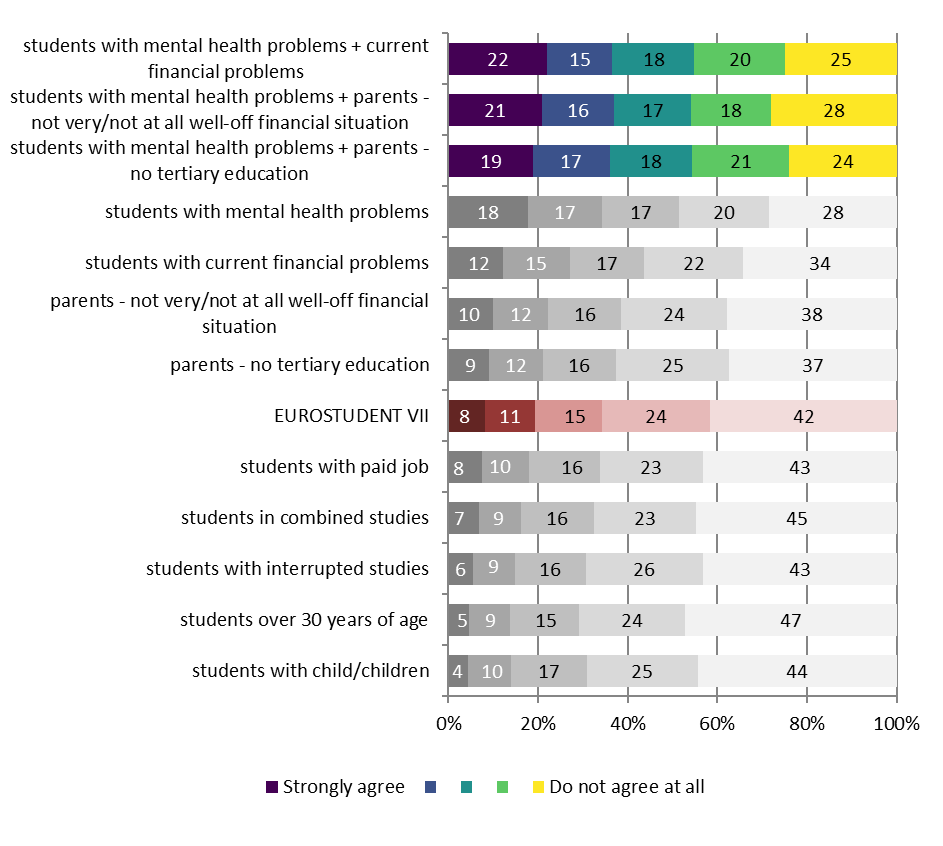Non-traditional students in the Czech higher education: who are they according to EUROSTUDENT VII data?
In recent decades, the higher education in the Czech Republic has undergone many changes. One of the most significant features of the development of tertiary education has been the growth in the number of students (Prudký, Pabian, ¦ima, 2009). This fact has brought inter alia an increasing diversity of student population. More often than in the past, we are encountering students who differ from those we perceive as traditional university students, i.e. young people aged 18–22 who are full-time students, entering university directly after the secondary school and mostly financially dependent on their parents.
The concept of non-traditional student is quite broad and there exist many definitions which are often conditioned by specific country contexts. In the Czech Republic we took into account following criteria, individually and in functional combinations: form of study (part-time study), age (30 years and older), parenthood (students with children), work experience (students with regular work experience of at least one year and with more than 20h per week), interrupted educational career before entering higher education (for at least 2 years), health problem/impairment (physical health problem, mental health problem, mobility impairment, sensory impairment, learning disability, another long-standing health problem), social disadvantage (parents without tertiary education and/or financially not well-off families), financial burden (those working to support others financially).
Firstly, we analyzed the degree of integration of non-traditional learners into the learning environment, and secondly, the degree of vulnerability of the groups in terms of perceived difficulties in the study due to study-related aspects as well as challenges outside studies (e.g. financial difficulties, paid jobs, health issues, child care, other personal problems).
Two groups of non-traditional students have been profiled. The first one consists of students over 30 years of age (10 %), or having a child/children (8 %), in part-time study program (16 %)[1], having a paid job (28 %) and entering higher education with delay of more than two years after leaving school (8 %). The second group of non-traditional students includes students with particular health disadvantages, as well as students, who have financial problems and quite often students with lower socio-economic status. This group of non-traditional students can be described as non-traditional students with health issues and social disadvantages. The share of students indicating health problems that is limiting or extremely limiting in their studies varies between 2 % (physical health problem) to 6 % (mental health problem). Students who have experienced financial problems represent 20 % of all students and students from low socio-economic background represent 12 % of all students in the Czech Republic.
Contrary to our prediction, the first group of students perceive challenges related to their studies or outside studies problematic less often than the second group of non-traditional students and even less frequently compared to the average of the whole survey population. In fact, this group of non-traditional students reflects the societal changes and consequently the changes in the tertiary education, but their different study or life situation does not seem to be more challenging than their mates’.
On the other hand, the second group of non-traditional students perceives the study-related problems as well as challenges outside studies problematic and is almost always least satisfied with their studies.
The analysis pointed out that the lowest sense of belonging to studies and the highest likelihood of dropping out of studies characterize subgroups of students who have both mental health issues and financial problems. These subgroups of non-traditional students are more likely to experience problems with their studies and they are more likely to experience a loss of motivation.
The results of our analysis are shown in the graphs below. These are two examples of identification of the groups of non-traditional students with the university environment (Figure 1, 2). The graphs illustrate the difference between the two groups of non-traditional students and the groups of non-traditional students who suffer from “double” disadvantage. These groups of non-traditional students are also presented in comparison with the average of the whole Czech survey population. Students whose parents do not have tertiary education are highly represented (51%) in the Czech EUROSTUDENT VII survey (the generation of parents of today's students did not fully experience the stage of mass higher education). This group of students does not experience major problems in their studies. In the Czech context, this group of students is not considered as classic non-traditional group of students due to the educational structure of Czech population.
With regards to recent/current COVID-19 situation, when students are exposed to new situations resulting from cancellation of teaching on-campus, financial instability, loneliness, etc., increased attention needs to be paid to these groups of students. What do we mean specifically?
The student population of the Czech Republic has become more diverse, so there is a need to cover different demands and requirements of different groups of students. Firstly, although there are specialized university counselling centers at the Czech universities that traditionally provide support for students mainly with health disadvantages such as sensory impairments or physical limitations, there is a lack of services and support for other disadvantaged group of students. As our research shows, when problems accumulate, problems with studies increase. Especially for those students who suffer with e.g. mental and financial problems together. So counselling centers at universities should focus on tracking these groups of students as their early identification and availability of relevant information for them can lead to higher success in their studies. Although we don´t know yet if and how these groups have suffered considerably during the COVID19 period and long period of distant teaching and learning[2] , we can estimate that this experience should change university approach to mental health and wellbeing of students significantly. Will EUROSTUDENT VIII provide some new evidence about it the next year? As researchers, we are looking forward to it!
Figure 1: I am seriously thinking of completely abandoning my higher education studies

Figure 2: I often have the feeling that I don't really belong in higher education

Reference
Prudký, L., Pabian, P., ¦ima, K. 2009. České vysoké ¨kolství. Na cestě od elitního k univerzálnímu vzdělávání 1989–2009. Praha: Grada Publishing, 2010, s. 27–59. ISBN 978-80-247- 3009-7.
[1] In fact, in the Czech Republic there exists only so called “combined study“ which we took as an equivalent to part time study.
[2] We have some surveys on COVID impact on students but there is still a lack of information regarding specific demands of students with e.g. mental problems and/or financial problems and its combinations.
